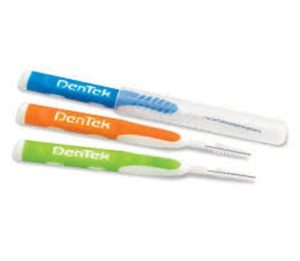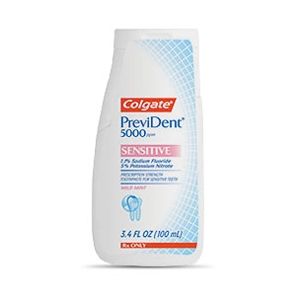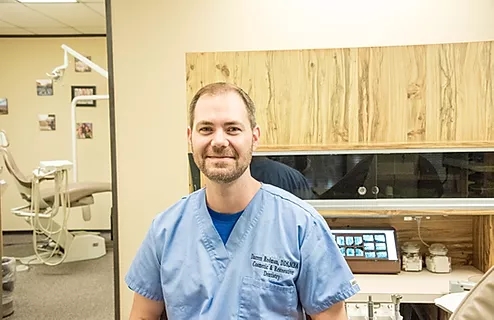Seniors and Oral Health Care III – 4 Dental Tips for Seniors
As a practicing general dentist, I see patients of all ages. Although each patient is unique, there are certain patterns to the oral health care challenges each age group faces. Today I am focusing on tips for seniors to help them maintain a healthy dentition even into their later years. In fact, these are recommendations I make to my own family members in order to avoid working on them! This regimen is recommended at least twice a day but particularly before bed so as not to go to sleep with plaque and food particles on the teeth.
• Clean between the teeth! The basic method of doing this is to use dental floss, although floss sticks can also accomplish this task if wielding a piece of dental floss between each tooth is too frustrating to coordinate. Floss is great for patients with little to no gum recession and very little open space between the teeth.
On the other hand, patients with gum recession and large open spaces between the teeth can benefit from interdental brushes. These fine brushes can be bent to slide easily between the teeth and sweep the sides of each tooth quite well while simultaneously massaging the gums.

• Clean all remaining sides of the teeth! I personally recommend an electric toothbrush for seniors. I have had equally good reports from patients regarding Sonicare and Oral-B toothbrushes. Using a soft bristle is ideal to avoid abrading away gum tissue over time and causing a further recession. One should let the brush do most of the work rather than scrubbing back and forth. I recommend letting the electric toothbrush vibrate or oscillate on the teeth and gums while gently moving the brush in small circles.
Start by brushing the front or cheek side of the teeth, then the biting surface, and finally the inside or tongue side of the teeth. Do this on both the top and bottom arches. After cleaning the teeth, gently brush the tongue, gums, and roof of the mouth to remove loose food particles and help with the breath.
• Rinse with a light fluoride mouthwash! I normally recommend ACT Anticavity. It is a mild fluoride rinse and should be swished for 1-2 minutes, which is quite a long time if you actually watch the clock. After spitting, do not eat or drink for 20 minutes, or simply go to bed. Although a fluoride rinse will not take away tooth decay, it can fortify vulnerable areas and prevent future decay. It’s cheap insurance! Many people get wrapped up on mouthwashes for gum health, but the flossing and brush do more to accomplish that.
• Dietary tips:
-Minimize high sugar and carbohydrate foods as they feed the bacteria that cause tooth decay.
-Minimize sodas since all sodas, including diet sodas, are acidic and can slowly dissolve the enamel. Sipping a single soda slowly over many hours is much more damaging than drinking one quickly and being done with it. It is all about how long you are exposing your teeth to the acid.
-Protein and fiber do not cause tooth decay
• Additional products for specific problems:
Dry Mouth
-Dry mouth is a very common problem among the elderly due to medications and reduced saliva flow with age. Dry mouth is very problematic as saliva protects the teeth and leaves one quite vulnerable to tooth decay when it is absent. I also recommend sleeping with a cup of water near the bed as saliva flow is lowest while we sleep, and water during the night helps to remoisten the oral tissues and provides comfort.
Biotene: lozenges, mouth rinses, and mouth sprays
Xylimelts: lozenges that coat and stimulate saliva flow containing xylitol which has been shown to reduce activity in bacteria that cause tooth decay
Tooth Decay
Prevident (Sodium Flouride gel/toothpaste): This is a prescription gel/toothpaste you can request from your dentist. It provides a higher level of fluoride than ACT Anticavity and is recommended for those who have a very high tooth decay rate. If your dentist is routinely finding tooth decay at each visit, it would be worth re-evaluating your habits and requesting a prescription for Prevident.

Fluoride Trays: For the most extreme tooth decay scenarios, I recommend making fluoride trays. These are flexible trays molded to the teeth exactly like bleaching trays for whitening. Instead of bleach, a thin ribbon of Prevident is placed in the trays and they are worn for 10-30 minutes each day. As stated before, this is usually reserved for extremely high tooth decay rates such as those seen in patients who have undergone head and neck radiation or who have certain autoimmune diseases which lead to extreme dry mouth.
Although following these tips is not a guarantee of avoiding tooth decay and gum disease, it will greatly reduce your risk of future problems. In closing, visit your dentist at least once every six months if not quarterly in order to maintain your oral health and catch any potential problems at an early stage.
Your dental ally,
Darren Redman, DDS
19 Briar Hollow Ln #140
Houston, TX 77027
713-621-7616


Recent Comments